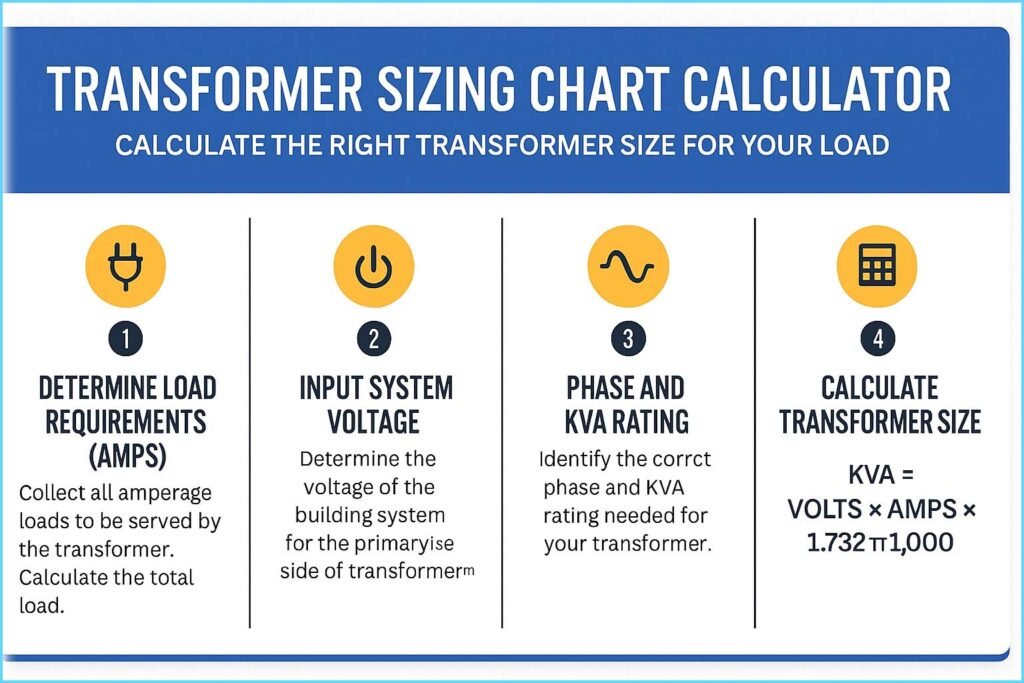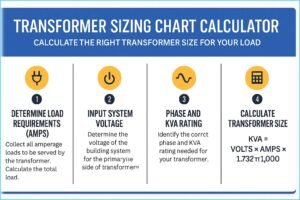Transformer Sizing Chart Calculator – Calculate the Right Transformer Size for Your Load
Selecting the right transformer size is one of the most important steps in designing an efficient electrical system. Whether it’s for an industrial facility, a commercial building, or a residential load, accurate transformer sizing ensures stable voltage, improved energy efficiency, and long-term reliability. That’s where a Transformer Sizing Chart Calculator becomes essential.
This calculator helps you quickly determine the ideal transformer capacity (in kVA) based on your connected load and voltage requirements. It simplifies what was once a tedious manual calculation, helping engineers, contractors, and homeowners save time and prevent costly oversizing or undersizing errors.

Table of Contents
In this article, we’ll explore how a Transformer Sizing Chart Calculator works, how to use it effectively, and what factors influence transformer capacity. You’ll also find a complete sizing chart and useful formulas that make transformer selection easier and more accurate.
Key Takeaways
- The Transformer Sizing Chart Calculator provides quick and accurate kVA values for your connected load.
- Proper transformer sizing improves efficiency, reduces energy losses, and extends equipment life.
- Always consider load type (single-phase or three-phase), power factor, and future expansion when using the calculator.
Understanding the Transformer Sizing Chart Calculator
A Transformer Sizing Chart Calculator converts your total electrical load into transformer capacity, measured in kilovolt-amperes (kVA). It works by using the basic relationship between voltage, current, and apparent power.
Transformer Sizing Chart Calculator
Estimate transformer rating based on load, power factor, voltage, and future margin. Includes standard sizing chart for quick selection.
For example, in simple terms:
kVA = (Voltage × Current) / 1000
However, real-world loads vary. Power factor, motor starting current, and load type all affect the required transformer size. That’s why modern calculators include these variables to give precise sizing results.
The calculator uses your input data—such as load in kilowatts (kW), system voltage, and load type—to generate the transformer rating in kVA. This ensures the selected transformer can handle the total current demand under normal and peak conditions.
Use our online tool Transformer Inrush Current Calculator – Accurate Tool for Power System Engineers
Why Correct Transformer Sizing Matters
An undersized transformer may overheat, cause voltage drops, and trip breakers during heavy loads. Oversizing, on the other hand, increases initial costs and leads to unnecessary power losses during low-load operation.
Using a Transformer Sizing Chart Calculator helps you find the balance. It ensures that your transformer operates efficiently under full load without exceeding its thermal limit. Correct sizing improves safety, extends lifespan, and optimizes system performance.
Properly sized transformers also ensure compliance with IEC and IEEE standards, which require sufficient margin for overload and harmonic distortion in sensitive equipment.
Formula Used in Transformer Sizing Chart Calculator
The basic formulas vary depending on the system configuration.
For Single-Phase Systems:
kVA = (Volts × Amps) / 1000
For Three-Phase Systems:
kVA = (Volts × Amps × √3) / 1000
To determine the current required:
Amps = (kVA × 1000) / (Volts × √3)
These equations are used inside the calculator to instantly compute the transformer size once you enter load and voltage details.
Use our online tool Single Phase Transformer Calculator – Accurate Transformer Sizing & Efficiency Tool
Transformer Sizing Chart (Approximate Guide)
Here’s a quick reference chart showing estimated kVA ratings based on typical load current and voltage.
| Load (kW) | Voltage (V) | Power Factor | System Type | Required kVA | Recommended Transformer Size |
|---|---|---|---|---|---|
| 10 kW | 415V | 0.8 | 3 Phase | 15.6 kVA | 16 kVA |
| 20 kW | 415V | 0.8 | 3 Phase | 31.2 kVA | 32 kVA |
| 30 kW | 415V | 0.8 | 3 Phase | 46.8 kVA | 50 kVA |
| 50 kW | 415V | 0.8 | 3 Phase | 78.1 kVA | 80 kVA |
| 75 kW | 415V | 0.8 | 3 Phase | 117.2 kVA | 125 kVA |
| 100 kW | 415V | 0.8 | 3 Phase | 156.3 kVA | 160 kVA |
| 150 kW | 415V | 0.8 | 3 Phase | 234.4 kVA | 250 kVA |
| 200 kW | 415V | 0.8 | 3 Phase | 312.5 kVA | 315 kVA |
| 300 kW | 415V | 0.8 | 3 Phase | 468.8 kVA | 500 kVA |
This chart provides a practical reference when estimating transformer size before using the Transformer Sizing Chart Calculator for precise results.
How to Use the Transformer Sizing Chart Calculator
Using the calculator is simple, even for beginners. Follow these easy steps:
- Enter Load in kW: Input the total connected load of your equipment.
- Select System Voltage: Choose your system’s voltage level (e.g., 230V, 400V, 415V).
- Enter Power Factor: Typically between 0.8 and 1.0.
- Choose System Type: Select single-phase or three-phase.
- Click “Calculate”: The calculator instantly provides transformer capacity in kVA and suggests the nearest standard rating.
It’s that straightforward. The Transformer Sizing Chart Calculator performs all the conversions for you and even includes safety margins for future load expansion.
Use our online tool EV Charger Energy Usage Cost Calculator
Factors to Consider When Sizing a Transformer
While the calculator gives an accurate result, you should still consider the following factors before finalizing transformer size:
1. Load Type:
Resistive loads (like lighting) and inductive loads (like motors) have different power factors. Inductive loads draw more reactive power and may need a larger transformer.
2. Starting Current:
Motors, compressors, and pumps have high inrush currents during startup. Choose a transformer with enough capacity to handle these surges.
3. Future Expansion:
Always plan for future growth. A 10–20% margin is recommended to accommodate additional load.
4. Ambient Temperature:
High temperatures reduce transformer efficiency. Use derating factors if the operating temperature exceeds the standard design.
5. Harmonics:
Non-linear loads such as variable frequency drives (VFDs) create harmonics that distort current. Choose K-rated transformers if harmonic loads are significant.
Benefits of Using a Transformer Sizing Chart Calculator
A Transformer Sizing Chart Calculator offers several key advantages over manual calculations.
- Accuracy: Instantly provides exact transformer size based on inputs.
- Efficiency: Reduces time spent on manual computation.
- Safety: Prevents overloading and under-sizing issues.
- Convenience: Suitable for both professionals and non-technical users.
- Cost Savings: Helps you select the right transformer without unnecessary oversizing.
Using an online tool ensures consistent and reliable results across multiple projects, making it a valuable resource for electrical engineers and project designers.
Use our online tool EV Charger Load Calculation Tool – Accurate Power Estimation for Home and Commercial EV Chargers
Example Calculation
Let’s say your total load is 50 kW on a 415V, 3-phase system with a power factor of 0.8.
kVA = (kW) / (Power Factor)
kVA = 50 / 0.8 = 62.5 kVA
The next standard transformer size would be 63 kVA.
The calculator does this instantly and provides recommendations for nearby standard transformer ratings for your specific setup.
Applications of Transformer Sizing
The Transformer Sizing Chart Calculator is widely used in:
- Industrial power systems
- Commercial buildings
- Solar and renewable energy installations
- Residential power backup systems
- Data centers and automation setups
In solar applications, it can also be used to size step-up transformers for inverters and grid connections.
Advantages of Correct Transformer Selection
Accurate sizing ensures:
- Lower energy losses
- Stable voltage supply
- Extended transformer lifespan
- Reduced operational costs
- Compliance with electrical codes
By using the Transformer Sizing Chart Calculator, you’re not just choosing the right transformer — you’re optimizing your entire electrical system for performance and reliability.
Use our online tool Inverter Size Calculator VA Rating by Load – Find the Perfect Inverter for Your Home or Office
Final Thoughts
Transformer sizing is not a guessing game — it’s a calculated engineering process. With the help of the Transformer Sizing Chart Calculator, you can make informed decisions backed by real data and engineering formulas.
Whether you’re working on a new installation or upgrading an existing system, this calculator helps you select the correct transformer capacity, improve efficiency, and maintain system safety.
It’s fast, accurate, and essential for anyone serious about professional electrical design.
Follow Us on Social:
Subscribe our Newsletter on Electrical Insights to get the latest updates in Electrical Engineering.
#TransformerSizing, #TransformerCalculator, #ElectricalEngineering, #PowerTransformer, #TransformerSelection, #ElectricalDesign, #TransformerLoadCalculation, #EngineeringTools, #IndustrialPower, #EnergyEfficiency, #ElectricalSafety, #TransformerCapacity, #SolarSystemDesign, #ElectricalCalculations, #TransformerGuide
Transformer Sizing Chart Calculator – Calculate the Right Transformer Size for Your Load : Electrical Engineering Hub

Use our Transformer Sizing Chart Calculator to find the ideal transformer capacity for your electrical load. Simplify transformer selection with accurate calculations for residential, commercial, and industrial systems
Price Currency: USD
Operating System: All
Application Category: WebApplication
